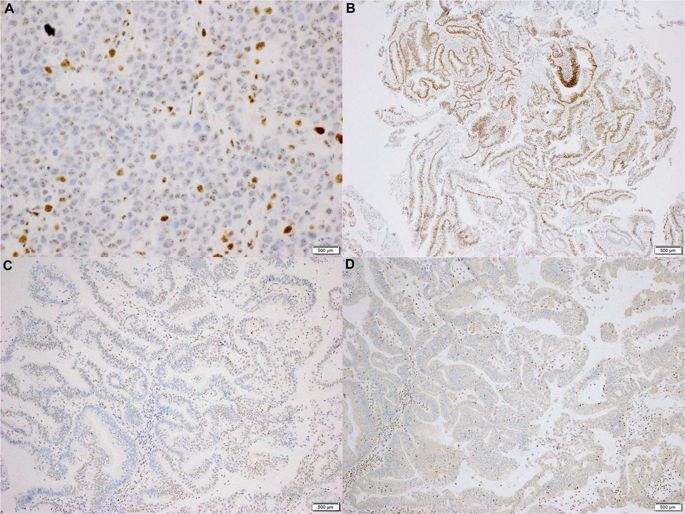当前位置:
X-MOL 学术
›
Modern Pathol.
›
论文详情
Our official English website, www.x-mol.net, welcomes your feedback! (Note: you will need to create a separate account there.)
Retained mismatch repair protein expression occurs in approximately 6% of microsatellite instability-high cancers and is associated with missense mutations in mismatch repair genes.
Modern Pathology ( IF 7.5 ) Pub Date : 2019-12-19 , DOI: 10.1038/s41379-019-0414-6 Jaclyn F Hechtman 1 , Satshil Rana 1 , Sumit Middha 1 , Zsofia K Stadler 2 , Alicia Latham 2 , Ryma Benayed 1 , Robert Soslow 1 , Marc Ladanyi 1 , Rona Yaeger 2 , Ahmet Zehir 1 , Jinru Shia 1
Modern Pathology ( IF 7.5 ) Pub Date : 2019-12-19 , DOI: 10.1038/s41379-019-0414-6 Jaclyn F Hechtman 1 , Satshil Rana 1 , Sumit Middha 1 , Zsofia K Stadler 2 , Alicia Latham 2 , Ryma Benayed 1 , Robert Soslow 1 , Marc Ladanyi 1 , Rona Yaeger 2 , Ahmet Zehir 1 , Jinru Shia 1
Affiliation

|
Immunohistochemistry for mismatch repair protein expression is widely used as a surrogate for microsatellite instability status-an important signature for immunotherapy and germline testing. There are no systematic analyses examining the sensitivity of immunohistochemistry for microsatellite instability-high status. Mismatch repair immunohistochemistry and microsatellite instability testing were performed routinely as clinically validated assays. We classified germline/somatic mutation types as truncating (nonsense, frameshift, and in/del) versus missense and predicted pathogenicity of the latter. Discordant cases were compared with concordant groups: microsatellite instability-high/mismatch repair-deficient for mutation comparison and microsatellite stable/mismatch repair-proficient for immunohistochemical comparison. 32 of 443 (7%) microsatellite instability-high cases had immunohistochemistry. Four additional microsatellite instability-high research cases had discordant immunohistochemistry. Of 36 microsatellite instability-high cases with discordant immunohistochemistry, 30 were mismatch repair-proficient, while six (five MLH1 and one MSH2) retained expression of the defective mismatch repair protein and lost its partner. In microsatellite instability-high tumors with discordant immunohistochemistry, we observed an enrichment in deleterious missense mutations over truncating mutations, with 69% (25/36) of cases having pathogenic germline or somatic missense mutations, as opposed to only 19% (7/36) in a matched microsatellite instability-high group with concordant immunohistochemistry (p = 0.0007). In microsatellite instability-high cases with discordant immunohistochemistry and MLH1 or PMS2 abnormalities, less cells showed expression (p = 0.015 and p = 0.00095, respectively) compared with microsatellite stable/mismatch repair-proficient cases. Tumor mutation burden, MSIsensor score, and truncating mismatch repair gene mutations were similar between microsatellite instability-high cases with concordant versus discordant immunohistochemical expression. Approximately 6% of microsatellite instability-high cases have retained mismatch repair protein expression and would be missed by immunohistochemistry-based testing, hindering patient access to immunotherapy. Another 1% of microsatellite instability-high cases show isolated loss of the defective gene's dimerization partner, which may lead to germline testing of the wrong gene. These cases are enriched for pathogenic mismatch repair missense mutations.
中文翻译:

保留的错配修复蛋白表达发生在大约 6% 的微卫星不稳定性高的癌症中,并且与错配修复基因中的错义突变有关。
错配修复蛋白表达的免疫组织化学被广泛用作微卫星不稳定性状态的替代指标——这是免疫治疗和种系检测的重要特征。没有系统的分析检查免疫组织化学对微卫星不稳定性高状态的敏感性。错配修复免疫组织化学和微卫星不稳定性测试作为临床验证的化验进行常规。我们将种系/体细胞突变类型分类为截短(无意义、移码和 in/del)与错义,并预测后者的致病性。将不一致的病例与一致的组进行比较:微卫星不稳定-高/错配修复-突变比较缺陷和微卫星稳定/错配修复-熟练进行免疫组织化学比较。443 例 (7%) 微卫星不稳定性高的病例中有 32 例进行了免疫组织化学检查。另外四个微卫星不稳定性高的研究案例具有不一致的免疫组织化学。在具有不一致免疫组织化学的 36 例微卫星不稳定性高的病例中,30 例错配修复熟练,而 6 例(5 例 MLH1 和 1 例 MSH2)保留了有缺陷的错配修复蛋白的表达并失去了其伴侣。在具有不一致免疫组织化学的微卫星不稳定性高的肿瘤中,我们观察到有害错义突变比截短突变丰富,69% (25/36) 的病例具有致病性种系或体细胞错义突变,而只有 19% (7/36) ) 在具有一致免疫组织化学的匹配微卫星不稳定性高组中 (p = 0.0007)。在具有不一致免疫组织化学和 MLH1 或 PMS2 异常的微卫星不稳定性高病例中,与微卫星稳定/错配修复熟练病例相比,较少细胞显示表达(分别为 p = 0.015 和 p = 0.00095)。肿瘤突变负荷、MSIsensor 评分和截断错配修复基因突变在免疫组织化学表达一致与不一致的高微卫星不稳定性病例之间相似。大约 6% 的微卫星不稳定性高的病例保留了错配修复蛋白表达,并且会被基于免疫组织化学的检测遗漏,从而阻碍患者获得免疫治疗。另外 1% 的微卫星不稳定性高的病例显示出缺陷基因的二聚化伙伴的孤立丢失,这可能导致错误基因的种系检测。
更新日期:2019-12-20
中文翻译:

保留的错配修复蛋白表达发生在大约 6% 的微卫星不稳定性高的癌症中,并且与错配修复基因中的错义突变有关。
错配修复蛋白表达的免疫组织化学被广泛用作微卫星不稳定性状态的替代指标——这是免疫治疗和种系检测的重要特征。没有系统的分析检查免疫组织化学对微卫星不稳定性高状态的敏感性。错配修复免疫组织化学和微卫星不稳定性测试作为临床验证的化验进行常规。我们将种系/体细胞突变类型分类为截短(无意义、移码和 in/del)与错义,并预测后者的致病性。将不一致的病例与一致的组进行比较:微卫星不稳定-高/错配修复-突变比较缺陷和微卫星稳定/错配修复-熟练进行免疫组织化学比较。443 例 (7%) 微卫星不稳定性高的病例中有 32 例进行了免疫组织化学检查。另外四个微卫星不稳定性高的研究案例具有不一致的免疫组织化学。在具有不一致免疫组织化学的 36 例微卫星不稳定性高的病例中,30 例错配修复熟练,而 6 例(5 例 MLH1 和 1 例 MSH2)保留了有缺陷的错配修复蛋白的表达并失去了其伴侣。在具有不一致免疫组织化学的微卫星不稳定性高的肿瘤中,我们观察到有害错义突变比截短突变丰富,69% (25/36) 的病例具有致病性种系或体细胞错义突变,而只有 19% (7/36) ) 在具有一致免疫组织化学的匹配微卫星不稳定性高组中 (p = 0.0007)。在具有不一致免疫组织化学和 MLH1 或 PMS2 异常的微卫星不稳定性高病例中,与微卫星稳定/错配修复熟练病例相比,较少细胞显示表达(分别为 p = 0.015 和 p = 0.00095)。肿瘤突变负荷、MSIsensor 评分和截断错配修复基因突变在免疫组织化学表达一致与不一致的高微卫星不稳定性病例之间相似。大约 6% 的微卫星不稳定性高的病例保留了错配修复蛋白表达,并且会被基于免疫组织化学的检测遗漏,从而阻碍患者获得免疫治疗。另外 1% 的微卫星不稳定性高的病例显示出缺陷基因的二聚化伙伴的孤立丢失,这可能导致错误基因的种系检测。



























 京公网安备 11010802027423号
京公网安备 11010802027423号